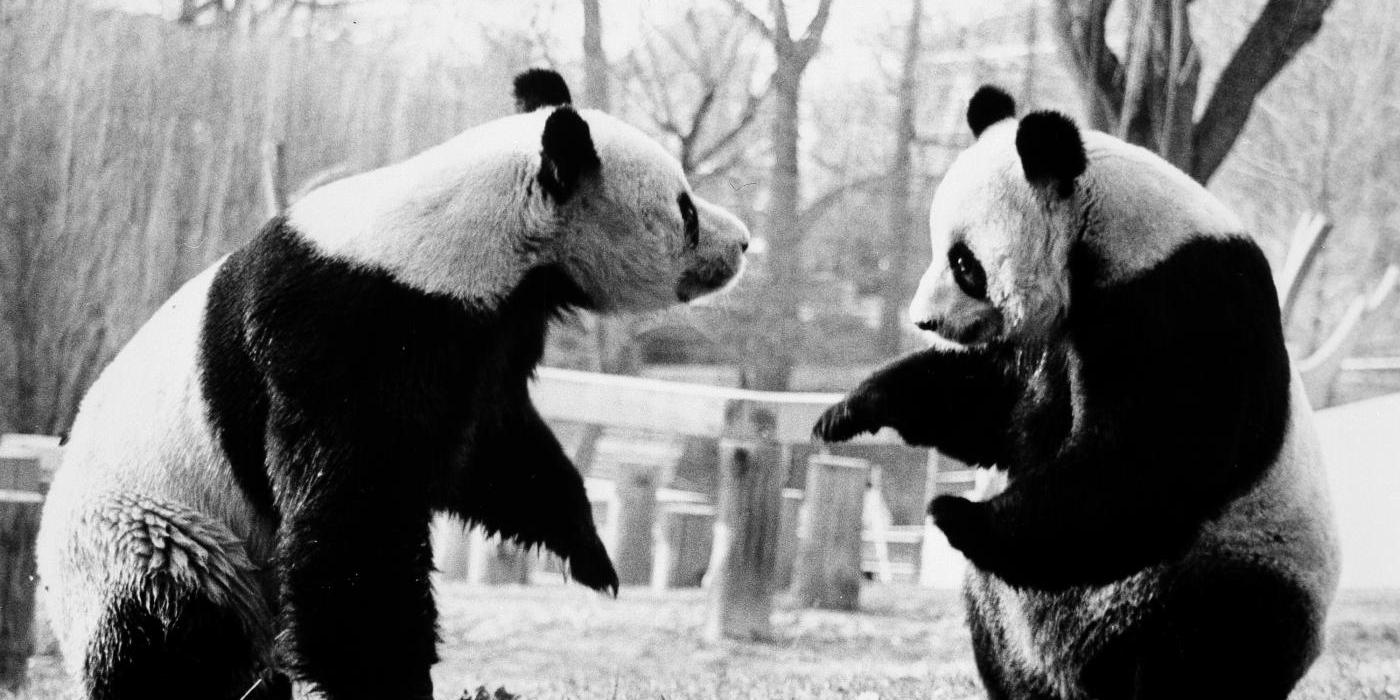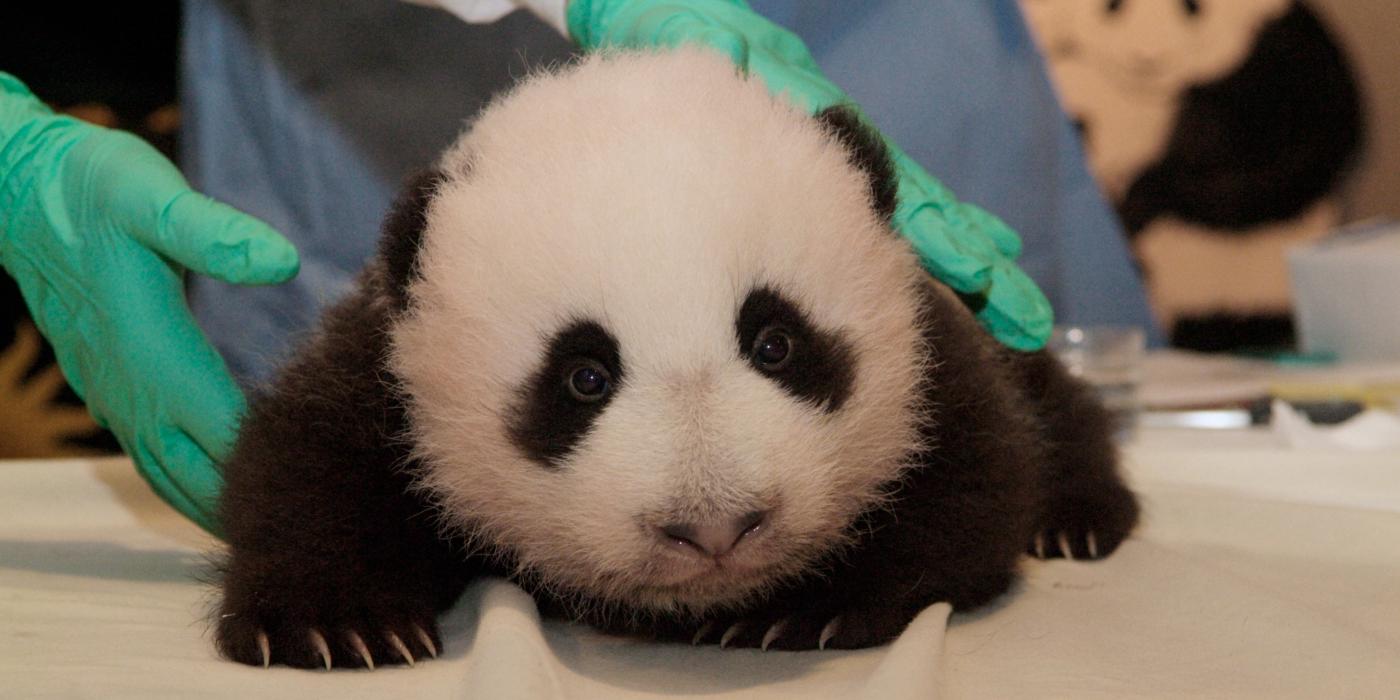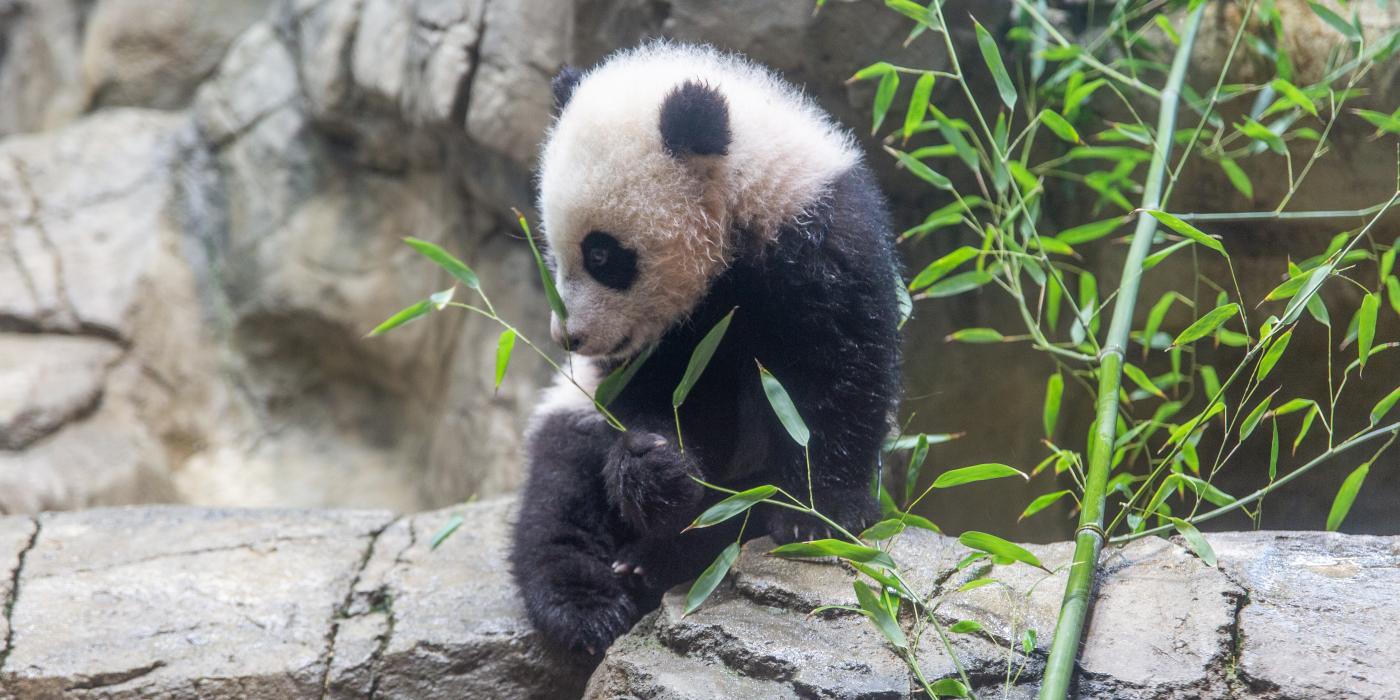The History of Giant Pandas at the Smithsonian's National Zoo and Conservation Biology Institute
Hsing Hsing and Ling Ling at the Smithsonian's National Zoo.
At dinner in Beijing, China, in February 1972, First Lady Patricia Nixon mentioned her fondness for giant pandas to Chinese Premier Zhou Enlai. As a gesture of goodwill following President Nixon’s seminal state visit, Premier Enlai gifted two giant pandas to the American people. Nestled in the Nation’s Capital and with free admission, the President and Mrs. Nixon selected the Smithsonian’s National Zoo as the home for the giant panda bears. On April 16, 1972, the giant pandas Ling-Ling (a female) and Hsing-Hsing (a male) arrived at their new home. Over the next 20 years, Ling-Ling and Hsing-Hsing produced five cubs. Sadly, none of the offspring survived for more than a few days. But ever since their arrival, the pandas have symbolized cross-cultural collaboration between the United States and China.
The arrival of the giant pandas drew millions of fans from around the world to the Zoo. It also gave the Smithsonian an unparalleled opportunity to study giant panda behavior, health, reproduction and ecology. Specifically, it allowed animal care staff and scientists to learn about panda estrus, breeding, pregnancy, pseudopregnancy and cub development as well as study giant panda native habitat in China. Over decades of joint efforts with Chinese partners, the Zoo’s breeding, veterinary and ecological research has provided critical data for the management of giant pandas in human care and valuable insights for the conservation of wild populations.
On Dec. 6, 2000, giant pandas Mei Xiang (female) and Tian Tian (male) came to live at the Zoo. Unlike Ling-Ling and Hsing-Hsing, the Zoo's second pair of pandas are on loan. In exchange, the Zoo contributes funds and expertise toward conservation efforts in China. The Zoo has renewed its Giant Panda Cooperative Research and Breeding Agreement with the China Wildlife Conservation Association three times since 2000.
On Nov. 8, 2023, Tian Tian, Mei Xiang and 3-year-old cub Xiao Qi Ji (male) departed from the Smithsonian's National Zoo and Conservation Biology Institute. As of December 2023, the pandas are housed at the China Conservation and Research Center for the Giant Panda's ShenShuPing Campus in Wolong.
Giant Panda Breeding, Research and Conservation Program Highlights Timeline
1972
Ling-Ling and Hsing-Hsing (shing-shing), the Zoo’s first pair of giant pandas, arrived from China in April as a gift to the American people to commemorate President Nixon’s historic visit to China. During their 20 years together at the Smithsonian's National Zoo, this panda pair produced five cubs; none of the cubs survived.
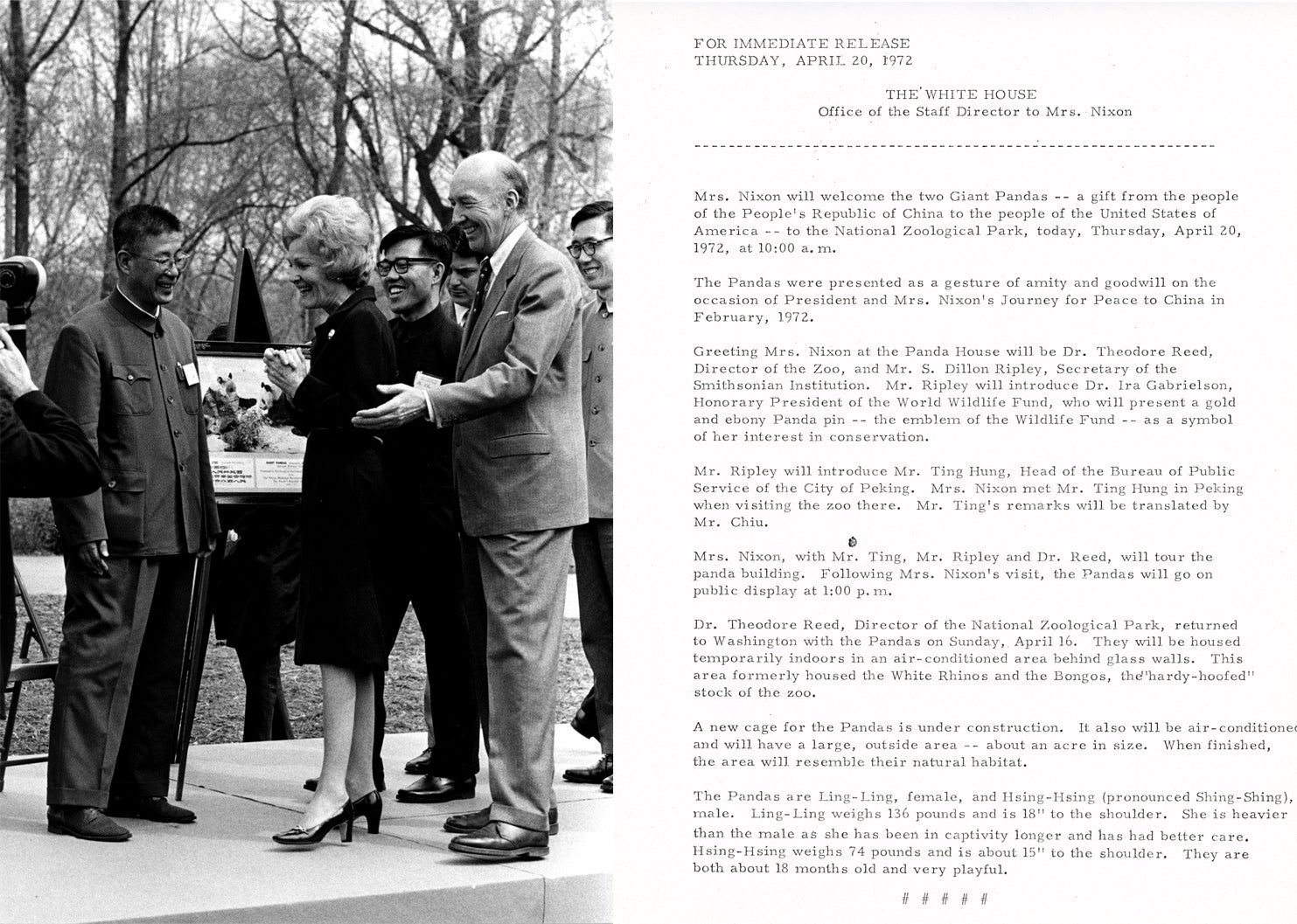
Left: First Lady Patricia Nixon at the Zoo April 20, 1972, for the official welcome ceremony for giant pandas Ling-Ling and Hsing-Hsing, a gift from China to the American people. Nixon is accompanied by Dr. Theodore Reed, director of the Zoo, and Smithsonian Secretary S. Dillon Ripley.
Right: A White House press release dated April 20, 1972, provides details on the welcome ceremony for giant pandas Ling-Ling and Hsing-Hsing. The panda pair first arrived at the Zoo April 16, 1972.
Photos courtesy of the Richard Nixon Presidential Library.
1983
After a decade of trial and error, Ling-Ling and Hsing-Hsing mated for the first time. Ling-Ling was also artificially inseminated with semen from Chia-Chia (cha cha), a giant panda in London. On July 21, Ling-Ling gave birth to a male cub that died three hours later of pneumonia. Using DNA analysis, Smithsonian Conservation Biology Institute scientists determined the cub was sired by Hsing-Hsing.
1984
The first publication on giant panda nature reserves by Smithsonian scientists was published. The article highlighted findings from some of the first visits by western scientists to three important giant panda reserves (Tangjiahe, Wanglang and Fengtongzhai) and included descriptions of the physiography, flora and fauna, and conservation management of these areas.
1984 – 1989
Ling-Ling and Hsing-Hsing produced four more cubs during this time. One cub was stillborn in 1984. Twins were born in 1987 ― one died quickly from a lack of oxygen and the other succumbed to an infection four days later. The last cub, born in 1989, died of pneumonia 23 hours after birth.
1983 – 1991
In addition to the five pregnancies, Ling-Ling also experienced many pseudopregnancies, when giant pandas’ behavior and hormones mimic a pregnancy even if they are not pregnant.
1992
Ling-Ling died Dec. 30, of heart failure; she was 23.
1999
Hsing-Hsing, suffering from several debilitating, age-related diseases, including terminal kidney disease, was euthanized Nov. 28, 1999; he was 28.
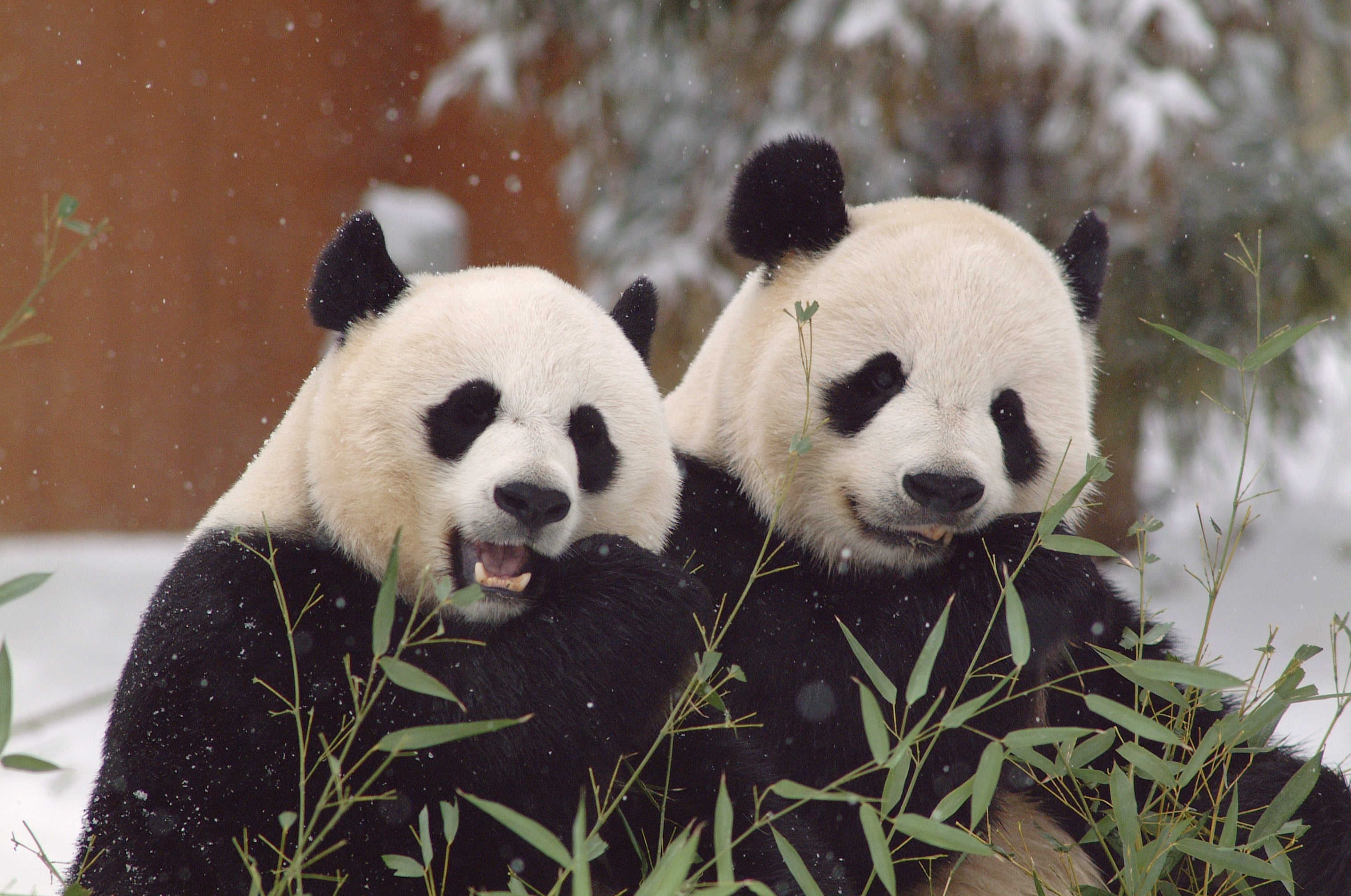
Tian Tian and Mei Xiang arrived at the Smithsonian's National Zoo in 2000.
2000
The Zoo’s second pair of giant pandas, Mei Xiang (may-SHONG) and Tian Tian (tee-YEN tee-YEN), arrived in Washington, D.C. Dec. 6. An agreement reached with the Chinese government stipulated the pair would live at the Zoo for 10 years in exchange for $10 million. Funds were raised from private donors, including Fujifilm and media partner Animal Planet.
2001
As part of long-term capacity building, Smithsonian ecologists led the first training in the use of geographic information systems or GIS in wildlife management for 50 protected area staff at Wolong Nature Reserve in China.
The Smithsonian's pioneering first attempts to cryopreserve giant panda semen showed it is resilient to cold storage at subzero temperatures. Frozen samples from genetically valuable male pandas could now be shipped between breeding institutions for artificial insemination and “banked” for use in the future.
2003
Mei Xiang and Tian Tian attempted to natural breeding but were unsuccessful.
2004
Scientists vaginally inseminated Mei Xiang with Tian Tian’s sperm during a non-anesthesia procedure after attempts at natural breeding were unsuccessful. Mei Xiang experienced a pseudopregnancy.
2005
Scientists and veterinarians artificially inseminated Mei Xiang March 11, after it was determined that no successful natural breeding occurred between the pandas during the previous 24 hours. Mei Xiang gave birth to the Zoo’s first surviving giant panda cub, Tai Shan, July 9, at 3:41 a.m.
On July 9, 2005, giant panda Mei Xiang gave birth to Tai Shan (pictured), the first surviving panda cub born at the Smithsonian's National Zoo.
2007
Scientists and veterinarians performed two artificial inseminations on Mei Xiang April 4 and 5. The procedures used semen collected from Gao Gao, the adult male at the San Diego Zoo. The procedures were unsuccessful and Mei Xiang experienced a pseudopregnancy.
2008
Scientists and veterinarians performed an artificial insemination on Mei Xiang March 19, using fresh semen from Tian Tian. The procedures were unsuccessful, and it is believed that Mei Xiang experienced either a pseudopregnancy or the loss of a developing fetus.
2009
Scientists artificially inseminated Mei Xiang Jan. 17, using a semen sample from Tian Tian. The procedures were unsuccessful and Mei Xiang expierenced a pseudopregnancy.
2010
Scientists artificially inseminated Mei Xiang Jan. 9 and 10, using semen from Tian Tian. Mei Xiang experienced a pseudopregnancy.
Tai Shan, the only surviving giant panda cub born at the Zoo, left for Wolong Nature Reserve, China, Feb. 4, to participate in breeding research.
By 2010, Smithsonian scientists and veterinarians published more than 50 books, book chapters, and scientific articles on captive and wild giant panda populations in collaboration with more than 100 Chinese co-authors.
2011
Dennis Kelly, director of the Smithsonian's National Zoo, and Zang Chunlin, secretary general of the China Wildlife Conservation Association, signed a new Giant Panda Cooperative Research and Breeding Agreement Jan. 20. The agreement stipulated that giant pandas Mei Xiang and Tian Tian would remain at the Zoo until Dec. 15, 2015.
Mei Xiang and Tian Tian’s attempts at natural breeding Jan. 29 were unsuccessful. Reproductive experts from China and the Smithsonian performed an artificial insemination with frozen semen collected from Tian Tian in 2005. A second artificial insemination was performed Jan. 30. Scientists confirmed that Mei Xiang experienced a pseudopregnancy July 21.
The Zoo announced David M. Rubenstein donated $4.5 million Dec. 19, to fund its giant panda program through the end of 2015. It also announced if Mei Xiang and Tian Tian failed to produce a cub in the 2012 breeding season, it was possible that both or one of the bears would return to China.
2012
A team of Smithsonian and Chinese scientists artificially inseminated Mei Xiang April 29 and 30, using semen from Tian Tian collected and frozen in 2005, after attempts at natural breeding were unsuccessful. Mei Xiang gave birth to a cub Sept. 16, at 10:46 p.m. The cub died Sept. 23. Necropsy results revealed that the cub was a female and had under-developed lungs, which resulted in liver damage.
Smithsonian ecologists and Chinese partners published one of the first studies showing the potential impacts of climate change to giant panda habitat and providing recommendations for mitigation strategies.
2013
Mei Xiang and Tian Tian attempted to mate March 29 but were unsuccessful. A team of Smithsonian scientists, veterinarians and Chinese colleagues performed two artificial inseminations on Mei Xiang March 30. The artificial inseminations used fresh semen and frozen semen from Tian Tian collected in 2003, and frozen semen collected in 2003 from the San Diego Zoo’s panda Gao Gao. Mei Xiang gave birth to Bao Bao Aug. 23 at 5:32 p.m. Mei Xiang gave birth to a second stillborn cub 26 hours later. DNA analysis confirmed Bao Bao was sired by Tian Tian.
Giant panda Bei Bei (pictured) was born Aug. 22, 2015, at the Zoo’s David M. Rubenstein Family Giant Panda Habitat. His name translates to “precious” or “treasure” in Chinese.
2014
By 2014, Smithsonian ecologists had trained more than 1,000 protected area staff, wildlife professionals and students in ecology, wildlife survey techniques and geospatial technologies in support of applied conservation research and management in China.
2015
Mei Xiang was artificially inseminated April 26 and 27. Both procedures used frozen semen from Hui Hui (hWEI-hWEI), a 10-year-old panda living in China, and fresh semen collected from Tian Tian. Veterinarians saw a fetus on an ultrasound Aug. 19. Mei Xiang gave birth to two male cubs Aug. 22, at 5:35 p.m. and 10:07 p.m. The smaller of the two cubs died Aug. 26. Zoo pathologists and veterinarians determined that complications associated with aspiration of food material into the cub’s respiratory system resulted in the development of pneumonia.
On Sept. 25, 2015, in celebration of the state visit and as a special honor for the Zoo’s cub, the First Lady of the United States, Michelle Obama, and the First Lady of the People's Republic of China, Peng Liyuan, named the cub Bei Bei (BAY-BAY) which means “precious, treasure” in Chinese.
Dennis Kelly, director of the Smithsonian's National Zoo, and Li Qingwen, deputy secretary general of the China Wildlife and Conservation Association (CWCA), signed a new Giant Panda Cooperative Research and Breeding Agreement effective through Dec. 7, 2020. The agreement was announced Nov. 19, 2015.
Smithsonian ecologists and Chinese partners published an article analyzing tracking data from giant pandas in the northern and western mountains, discovering distinct seasonal and daily movements between the groups, driven by differences in terrain, temperature, and bamboo nutrients. These behavioral differences are important considerations reintroducing giant pandas to the wild.
Smithsonian ecologists and Chinese partners published an examination of how giant pandas impact other species that share bamboo forest. This study directly improved the conservation of other native wildlife.
2016
Tian Tian slides in the snow during the infamous 2016 Washington, D.C. blizzard. The video capturing the moment was shared on January 23 across the Zoo’s social media channels and viewed more than 93.7 million times.
2017
Mei Xiang’s second surviving cub, Bao Bao, departed for China on Feb. 21, 2017. The Zoo created a #ByeByeBaoBao celebration and special video as part of her farewell.
2018
Smithsonian ecologists and Chinese partners published an article demonstrating that by utilizing biological traits of bamboo in climate change models, the predicted impact was not as severe as what has been predicted by models using only climate.
Smithsonian ecologists and Chinese partners published an article using giant panda data to advance selection of species distribution models, allowing for improved predictions of where species potentially could survive as climate changes.
2019
On Feb. 23, 2019, the Zoo hosted a public housewarming celebration to open the new exhibit inside the panda house at the David M. Rubenstein Family Giant Panda Habitat. The interactive exhibit highlights the ecology, history, reproduction, conservation and care of giant pandas through a series of games and activities.
Mei Xiang’s third surviving cub, Bei Bei, departed for China on Nov. 19, 2019. The Zoo created a #ByeByeBeiBei celebration and special video as part of his farewell.
Smithsonian ecologists and Chinese partners published an article showing how reserves established for one endangered species can be effective in conserving other endemic endangered species.
Smithsonian ecologists and international partners publish an article evaluating the potential for a large-scale bamboo flowering event in the Qinling and Minshan mountain ranges, which support the majority of wild giant pandas. Using scenario modeling the authors assess the risks and highlight measures to protect giant panda from severe population crashes.
With the birth of cub Xiao Qi Ji (pictured) on Aug. 21, 2020, Mei Xiang became the oldest giant panda in the United States and the second oldest documented in the world to give birth.
2020
Mei Xiang was artificially inseminated on March 22 using frozen semen from Tian Tian. Veterinarians saw fetal tissue on an ultrasound on Aug. 14 and Mei Xiang gave birth to a fourth surviving cub on Aug. 21, at 6:35 p.m. The cub is male. On Nov. 23, following a public vote, the cub was named Xiao Qi Ji (SHIAU-chi-ji) which means “Little Miracle” in Mandarin Chinese.
Xiao Qi Ji’s birth is the first outside of China from artificial insemination with frozen-thawed semen only and demonstrates the value and key role of systematic biobanking in species conservation. The semen used in 2020 to inseminate Mei Xiang was collected from Tian Tian and frozen in Feb. 2015.
On Dec. 7, 2020, the Zoo announced a three-year agreement extension that giant pandas will continue to live at the Zoo through the end of 2023. The three-year agreement extension signed by the Zoo and China Wildlife and Conservation Association. The terms of the agreement extension are similar to previous agreements. Xiao Qi Ji, Mei Xiang and Tian Tian will go to China at the end of the three-year agreement extension.
Smithsonian ecologists and Chinese partners published an article demonstrating how giant panda reserves have been very successful at conserving giant pandas but not large carnivores which have continued their decline over the same period giant panda populations have increased.
The Giant Panda National Park is officially established in China in 2020. Smithsonian ecologists and Chinese colleagues published an article on opportunities, challenges and management strategies for the park which incorporates 81existing protected areas and an additional ~6,000 km2 land previously unprotected.
Smithsonian ecologists and Chinese partners publish an article based on giant panda movement inside Wolong Nature Reserve. Using GPS tracking, the authors analyze giant panda microhabitat selection and home range to develop strategies for improving habitat management, restoration, and corridor construction.
2021
On Jan. 27, 2021, the Zoo provided a real-time, up-close look at giant panda cub Xiao Qi Ji during a livestream, broadcast simultaneously to the web, Facebook and YouTube.
On Jan. 31, Mei Xiang and Tian Tian were caught on the Zoo’s Panda Cam sliding and somersaulting in the freshly fallen snow. A video capturing the snow day frolic has been viewed more than 22 million times on the Zoo’s social media channels.
To date, Smithsonian ecologists have trained more than 1,500 protected area staff, wildlife professionals, and students in ecology, wildlife survey techniques, and geospatial technologies to support applied conservation research and management.
To date, Smithsonian scientists and veterinarians have collaborated with more than 150 Chinese partners to produce over 115 books, book chapters, and scientific articles on wild giant pandas, associated wildlife, their habitats, as well as husbandry, veterinary care, and reproductive research on giant pandas in human care.
Smithsonian ecologists and Chinese partners published an article using population densities of giant pandas in five nature reserves in the Qinling Mountains to identify potential dispersal routes and areas posing risks for depleting giant panda populations to inform decision makers and protected area design strategies.
2022
On Jan. 3, the Zoo shared a video of panda cub, Xiao Qi Ji, enjoying the first snow of the year in Washington, D.C. The 16-month-old cub plowed face-first into the fresh powder, belly-slid down a snow-covered hill and rolled around Mei Xiang.
Starting in April, Zoo marked the 50th anniversary of the panda program with a six-month-long celebration for its visitors and global online community. To commemorate and celebrate the Zoo’s in-residence giant panda family, the Zoo held in-person and online events, offered virtual panda-themed field trips through the National Head Start Program, published a Panda Family Tree Photo Gallery and paired with local and national businesses to offer panda-themed toys, apparel and food and drink specials. Additionally, the two-day Pandaversary event, held on April 16 and 17, marked the world premiere of the film "The Miracle Panda," produced by the Smithsonian Channel and narrated by Lucy Liu.
2023
As part of the terms of the 2020 agreement, the Smithsonian’s National Zoo and Conservation Biology Institute began preparations to send Tian Tian, Mei Xiang and Xiao Qi Ji to China by the end of the year.
From September 23 to October 1, 2023, the Zoo celebrated the pandas by hosting Panda Palooza: A Giant Farewell. During the nine-day family-friendly celebration, supported by entertainment partner Events DC and made possible with the support of Boeing, tens of thousands of visitors got a chance to say goodbye to the giant pandas while participating in family-friendly activities located throughout the Zoo. Meanwhile, the panda care team continued the process of preparing Tian Tian, Mei Xiang and Xiao Qi Ji for the move by initiating a crate training regimen designed to help the pandas feel comfortable and safe during the journey.
On Nov. 8, 2023, Tian Tian, Mei Xiang and Xiao Qi Ji departed from the Smithsonian’s National Zoo and Conservation Biology Institute (NZCBI) at 9:31 a.m. EST. After being driven to Dulles International Airport in northern Virginia, the pandas and boarded a dedicated and custom-decaled “FedEx Panda Express” Boeing 777F aircraft.
Joined by animal care staffers at the Smithsonian’s National Zoo and Conservation Biology Institute, the pandas traveled in specialized crates made of steel and plexiglass, weighing approximately 800 pounds each. Zoo staff traveled with approximately 220 pounds of bamboo, 8 pounds of leaf-eater biscuits, 5 pounds of low-starch biscuits, 6 pounds of apples, 5 pounds of carrots, 6 pounds of sweet potatoes, 3 pounds of sugar cane, 1 pound of pears and 1 pound of cooked squash.
After an approximately 19-hour, trans-Pacific flight, the pandas landed in Chengdu, China, and were driven to the China Conservation and Research Center for the Giant Panda ShenShuPing Campus in Wolong. After being unloaded from their travel crates, the pandas entered a brief quarantine period and began the process of acclimating to their new home.
2024
On May 29, 2024, the Smithsonian’s National Zoo and Conservation Biology Institute announced it will welcome a new pair of giant pandas, Bao Li [BOW-lee] and Qing Bao [ching-BOW], to the Zoo by the end of 2024. In the video announcement, First Lady of the United States of America Dr. Jill Biden joined Smithsonian Secretary Lonnie G. Bunch III and Brandie Smith, NZCBI’s John and Adrienne Mars Director, to reveal pandas are coming back to the nation’s capital.
A cooperative research and breeding agreement was signed by Smith and Wu Minglu, secretary general of the China Wildlife Conservation Association (CWCA), effective through April 2034.
The terms of the new agreement are similar to previous agreements. A male and female giant panda recommended for breeding will be sent from China to NZCBI. Both adults and any offspring remain under the ownership of China. Any cubs born at NZCBI will move to China by the age of 4. As part of the agreement, NZCBI and partners in China will conduct cooperative research projects in China and at the Zoo in Washington, D.C. In line with all zoos outside of China who care for and exhibit giant pandas, NZCBI will pay a $1 million annual fee to CWCA to support research and conservation efforts in China. Federal funding is not used to pay the annual fee.
After months of planning and preparation, giant pandas Bao Li and Qing Bao arrived at the Smithsonian’s National Zoo and Conservation Biology Institute (NZCBI) Oct. 15, 2024, at approximately 11:30 a.m. ET. They began their journey early in the morning in China aboard a dedicated “FedEx Panda Express” Boeing 777F aircraft. The approximately 19-hour, 8,250-mile trans-Pacific trip from Chengdu, China, to Washington, D.C., included a brief refueling stop in Anchorage, Alaska. The flight arrived at Dulles International Airport in Northern Virginia at 9:52 a.m. EDT, where the pandas were loaded onto FedEx trucks before heading to the Zoo.
